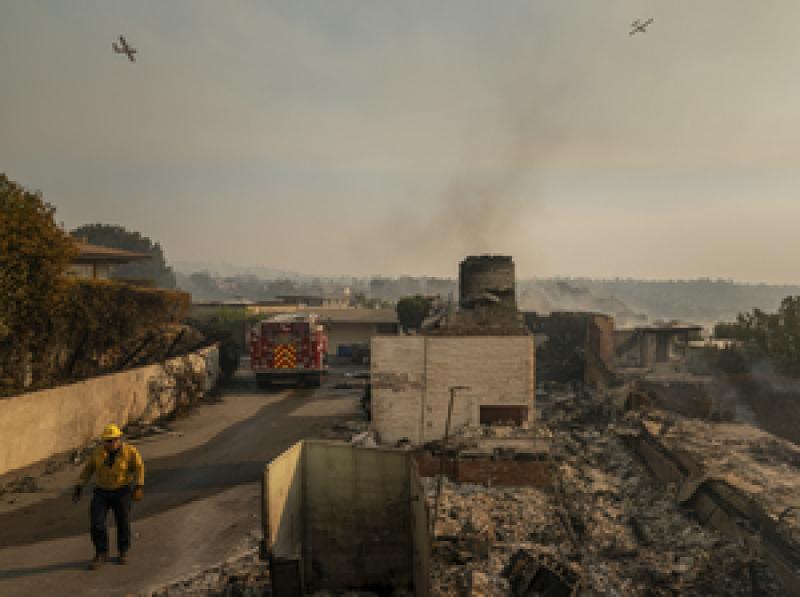LA Fires Show Limits of America’s Efforts to Cope With Climate Change


Perhaps the most aggressive type of adaptation is simply being honest. Officials should start telling people in dangerous areas that their homes can’t be protected, according to Michele Steinberg, the wildfire division director with the National Fire Protection Association.

LA Fires Show Limits of America’s Efforts to Cope With Climate Change
Flavelle, Christopher.67-85 minutes
LA Fires Show Limits of America’s Efforts to Cope With Climate Change
A firefighter looks for hotspots as firefighting tanker aircraft circle overhead amid the Palisades fire in the Pacific Palisades neighborhood of Los Angeles, on Thursday, Jan. 9, 2025. The most destructive fires in the history of Los Angeles still raged Thursday, after killing at least five people and destroying at least 2,000 structures. (Loren Elliott/The New York Times)
This week’s fires around Los Angeles present a puzzle: Why is California, the state best equipped to deal with wildfires, seemingly unable to prevent blazes from consuming entire chunks of the country’s second-largest city?
California’s building code for wildfires is among the most protective in the nation. Its local fire departments are backed up by CalFire, the state fire agency, which has a $4 billion budget and some of the best-trained firefighters in the world. The state’s huge tax base generates effectively unlimited resources for wildfire protection. And California has mandatory statewide requirements that homeowners in risky areas create “defensible space” around their property — rules that other Western states would like to apply but can’t because it would anger conservative voters.
Yet the events of this week demonstrate the limits of those efforts, raising uncomfortable questions about whether any part of the United States — even the wealthiest, best prepared and most experienced — can truly adapt to wildfires made worse by a hotter climate.
“Climate change, and climate events, are causing us to butt up against that limit,” said Joshua Saks, the adaptation program director for Georgetown Climate Center at Georgetown University Law Center in Washington. “The risk will always grow, and at some point outpace what you’ve done.”
Part of the extensive damage from the fires in Los Angeles may reflect errors in planning or execution. Fire hydrants designed to fight house fires ran dry, as water reserves faced greater demand than officials anticipated. It’s not clear that residents had sufficient warning or that evacuation routes were well planned. The second-guessing and questions about accountability have begun even as the fires continue to rage.
But there is no escaping the fact that wildfires in the American West are growing worse. Rising temperatures mean drier vegetation, which creates more fuel for fires; it also means those fires are harder to extinguish once they start. An analysis of 60,000 wildfires between 2001 and 2020 found that fires are spreading faster over time, in California and other Western states.
There are fundamentally two ways to prepare for wildfires and other climate shocks.
One is to try to fortify communities without fundamentally changing them. That kind of adaptation, often called resilience, is where California excels, at least compared with most Western states.
In 1961, a wildfire made worse by Santa Ana winds destroyed almost 500 homes in the Bel Air neighborhood of Los Angeles. In the aftermath, the city banned wood shingles on new homes and mandated rules around clearing brush.
That approach eventually spread across the state. By 2008, California adopted as part of its state building code a series of requirements governing how homes are to be constructed in areas at high risk of fires. Builders must use materials that are unlikely to burn, such as stucco, concrete or steel. Homeowners must thin or remove vegetation up to 100 feet from the edge of buildings. Now, the state is even looking at establishing a so-called zone zero in the 5 feet immediately around houses, requiring the removal of all flammable material.
Many states have comparable guidelines. But California’s state rules regarding building materials and clearing vegetation are mandatory — local officials don’t have the ability to ignore or overrule them.
Still, the state’s building code doesn’t solve the problem of homes and neighborhoods that were built before those standards took effect, noted Roy Wright, who managed risk mitigation programs for the Federal Emergency Management Agency during the Obama and Trump administrations. Many of those homes are in areas with high fire risk.
The other kind of adaptation entails more aggressive changes, experts said. It involves measures that could make communities more wildfire-resistant even as the climate gets hotter. But very few communities have ever tried them because they would drastically change the nature of neighborhoods, which would be unpopular, costly or both.
Those measures include cutting down trees, Wright said, so that fires don’t spread as easily, even if that strips away the character that attracted people in the first place. It means banning wood decks or fences, the kind of aesthetic details that homeowners value.
“Very little can stop this kind of fire, short of the construction of fireproof bunkers,” said Jesse Keenan, a professor at Tulane University who specializes in climate adaptation.
When it comes to rebuilding after a disaster, it could mean leaving more space between homes, Wright said. But that means fewer or smaller homes, which is likely to face objections from homeowners and local officials.
In Los Angeles, another approach would be to build a half-mile buffer zone between neighborhoods and the forests that surround them.
“What ultimately moves these fires is the ember comes in and then it ignites the house, and then that house produces the embers that cause the next one,” Wright said. “Make sure that when the embers come out of the wooded area, they don’t ignite anything.”
Another example of a more aggressive kind of adaptation means building fewer homes in high-risk areas in the first place, and drastically changing neighborhoods that already exist to make them less fire-prone, Keenan said.
But local officials who approve where homes get built have a strong incentive to encourage development even in risk-prone areas because it means more property tax revenue, said Kate Gordon, a former senior climate adviser to California Gov. Gavin Newsom.
The Los Angeles fires could force state and local officials to recalculate where new construction takes place, Gordon said. “I think we’ll have that conversation,” she said. “Continuing to do policy the way we have, as if this is an outlier, is just devastating.”
The fires might spur another change in how California approaches adaptation, Gordon said. In areas that frequently flood, government agencies offer homeowners money to move — a strategy sometimes called managed retreat. She said it’s time to consider applying that idea to areas exposed to wildfires.
Perhaps the most aggressive type of adaptation is simply being honest. Officials should start telling people in dangerous areas that their homes can’t be protected, according to Michele Steinberg, the wildfire division director with the National Fire Protection Association.
She cited the example of Hollywood Hills, which was built up a century ago without wildfires in mind, and has been threatened by the Sunset fire. “It’s not a place that I would ever develop homes,” Steinberg said. “It’s not safe.”
It may be necessary to tell homeowners in the Hollywood Hills, where the median sales price was $1.8 million in November, that the wildfire risk is so great, they may not be able to protect their properties, Steinberg said.
“Elected officials, the fire service, the insurance industry, needs to let folks know,” Steinberg said. “You say, ‘There’s not a way — in a major event, in a very extreme wildfire — that we can do anything for you. You just need to know that.’”
This article originally appeared in The New York Times.
Flavelle, Christopher.67-85 minutes



The government cant tell people where to live but maybe it should be able to tell them there is a limit on how much help they will receive if natural disaster strikes.
For staters, governments can stop prohibiting insurance companies from appropriately pricing policies for people who live in high risk areas.
I have an in-law who, lives in Florida. She was notified late last year that her home owner's insurance will no longer be covering homes along the coast where she lives. Insurance company was not prohibited from doing that, despite them still doing business in Florida. The company's remaining are charging exorbitant prices for that coverage.
While I am not totally opposed to allowing them to do that, it has to be balanced with regulations preventing them from price gouging their customers.
I have a brother who has a house in Punta Gorda Florida. The insurance company wants about 25,000 dollars a year to insure his house , and he said no. He could afford it more than some people, but decided it the price wasnt worth it. If his house gets damaged in a hurricane he will repair it or whatever with his own money.
From what I have read it seems insurance companies have been making the statement for awhile.
Fires in the west, tornadoes in the Midwest and hurricanes in the SE, like CA here in Florida there is an insurance disaster, many companies have pulled out of the market and many smaller ones have gone bankrupt with the state of FL now being the insurers of last resort with rates that are sky high. It is going to spread to other states as well.
Will the US government become the insurer of last resort of all types of home owner insurance like they are with flood insurance, if something isn’t done soon the market are going only cover few homeowners and that will lead to diasterious results for all.